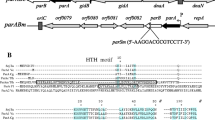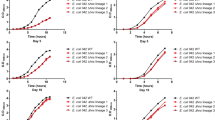Summary
The Escherichia coli htpR (=hin, rpoH) mutants are defective in the induction of heat-shock proteins due to a deficiency in sigma 32 and are unable to grow at high temperature. We found that these mutants are also defective in supporting replication of certain plasmids including F and mini-F. When a htpR mutation is introduced into an F′ strain, the F′ plasmid is effectively excluded. Similarly, when an F′ or mini-F plasmid is introduced into htpR mutant cells, transconjugant or transformant clones are obtained at low frequencies and the plasmid is rapidly lost upon subsequent growth in a non-selective medium. In htpR amber mutants carrying a temperature-sensitive suppressor, mini-F replication occurs normally at 30° C, but is inhibited upon transfer to 40° C where the suppressor tRNA is inactivated. A temperature-resistant “pseudo-revertant” of the htpR6 (amber) mutant, that exhibits apparently normal induction of the major heat-shock proteins in the absence of functional sigma 32, fails to support mini-F replication at 40° C, suggesting that inhibition of mini-F replication is not a secondary consequence of the defective induction of the major heat-shock proteins. It is proposed that the function of the sigma 32 protein is directly required for F plasmid replication.
Similar content being viewed by others
References
Anderson KW, Smith JD (1972) Still more mutant tyrosine transfer ribonucleic acids. J Mol Biol 69:349–356
Bergquist PL, Downard RA, Caughey PA, Gardner RC, Lane HED (1981) Analysis of mini-F plasmid replication by transposition mutagenesis. J Bacteriol 147:888–899
Bolivar F, Rodriguez RL, Greene PJ, Betlach MC, Heyneker HL, Boyer HW (1977) Construction and characterization of new cloning vehicles. II. A multipurpose cloning system. Gene 2:95–113
Casadaban M (1976) Transposition and fusion of the lac gene to selected promoters in Escherichia coli using bacteriophage lambda and mu. J Mol Biol 104:541–555
Chang ACY, Cohen SN (1978) Construction and characterization of amplifiable multicopy DNA cloning vehicles derived from the P15A cryptic miniplasmid. J Bacteriol 134:1141–1156
Falkinham III JO (1979) Gene lon and plasmid inheritance in Escherichia coli K-12. J Bacteriol 139:1054–1057
Goff SA, Goldberg AL (1985) Production of abnormal proteins in E. coli stimulates transcription of lon and other heat shock genes. Cell 41:587–595
Goff SA, Casson LP, Goldberg AL (1984) Heat shock regulatory gene htpR influences rates of protein degradation and expression of the lon gene in Escherichia coli. Proc Natl Acad Sci USA 81:6647–6651
Grossman AD, Erickson JW, Gross CA (1984) The htpR gene product of E. coli is a sigma factor for heat-shock promoters. Cell 38:383–390
Ish-Horowicz D, Burke JF (1981) Rapid and efficient cosmid cloning. Nucleic Acids Res 9:2989–2998
Kline BC (1985) A review of mini-F plasmid maintenance. Plasmid 14:1–16
Landick R, Vaughn V, Lau ET, Van Bogelen RA, Erickson JW, Neidhardt FC (1984) Nucleotide sequence of the heat shock regulatory gene of E. coli suggests its protein product may be a transcription factor. Cell 38:175–182
Lane HED (1981) Replication and incompatibility of F and plasmids in the IncF1 group. Plasmid 5:100–126
Laskey RA (1980) The use of intensifying screens or organic scintillators for visualizing radioactive molecules resolved by gel electrophoresis. Methods Enzymol 65:363–371
Maki S, Kuribayashi M, Miki T, Horiuchi T (1983) An amber replication mutant of F plasmid mapped in the minimal replication region. Mol Gen Genet 191:231–237
Maniatis T, Fritsch EF, Sambrook J (1982) Molecular cloning. Cold Spring Harbor Laboratory, New York
Miller JH (1972) Experiments in molecular genetics. Cold Spring Harbor Laboratory, New York
Neidhardt FC, Van Bogelen RA (1981) Positive regulatory gene for temperature-controlled proteins in Escherichia coli. Biochem Biophys Res Commun 100:894–900
Osawa T, Yura T (1981) Effects of reduced amount of RNA polymerase sigma factor on gene expression and growth of Escherichia coli: Studies of the rpoD40 (amber) mutation. Mol Gen Genet 184:166–173
Ozeki H, Inokuchi H, Yamao F, Kodaira M, Sakano H, Ikemura T, Shimura Y (1980) Genetics of nonsense suppressor tRNAs in Escherichia coli. In: Söll D, Abelson JN, Schimmel PR (eds) Transfer RNA: Biological aspects. Cold Spring Harbor Laboratory, New York, pp 341–362
Phillips TA, Van Bogelen RA, Neidhardt FC (1984) lon gene product of Escherichia coli is a heat-shock protein. J Bacteriol 159:283–287
Timmis K, Cabello F, Cohen SN (1975) Cloning, isolation, and characterization of replication regions of complex plasmid genomes. Proc Natl Acad Sci USA 72:2242–2246
Tobe T, Ito K, Yura T (1984) Isolation and physical mapping of temperature-sensitive mutants defective in heat-shock induction of proteins in Escherichia coli. Mol Gen Genet 195:10–16
Wada C, Yura T (1984) Control of F plasmid replication by a host gene: Evidence for interaction of the mafA gene product of Escherichia coli with the mini-F incC region. J Bacteriol 160:1130–1136
Yamamori T, Yura T (1982) Genetic control of heat-shock protein synthesis and its bearing on growth and thermal resistance in Escherichia coli K-12. Proc Natl Acad Sci USA 79:860–864
Yura T, Tobe T, Ito K, Osawa T (1984) Heat shock regulatory gene (htpR) of Escherichia coli is required for growth at high temperature but is dispensable at low temperature. Proc Natl Acad Sci USA 81:6803–6807
Author information
Authors and Affiliations
Additional information
Communicated by M. Takanami
Rights and permissions
About this article
Cite this article
Wada, C., Akiyama, Y., Ito, K. et al. Inhibition of F plasmid replication in htpR mutants of Escherichia coli deficient in sigma 32 protein. Molec Gen Genet 203, 208–213 (1986). https://doi.org/10.1007/BF00333956
Received:
Issue Date:
DOI: https://doi.org/10.1007/BF00333956




